Best AI Knowledge Base Software in 2026
Learn more about AI-powered knowledge base software tools and types, with examples.
Every day, we’re bombarded with information—emails, news articles, research papers, social media posts. Keeping it all organized and finding what’s important when we need it is a daunting task.
This is where AI knowledge bases come in. These systems are designed to not just store information, but to make sense of it, helping us to navigate the flood of data more effectively.
What makes AI knowledge bases stand out is their ability to think like humans—connecting dots, understanding context, and even learning from experience. This isn’t just about faster searches or better recommendations; it’s about transforming how we interact with information on a fundamental level.
But what exactly are AI knowledge bases, and why do they matter? In this article, we’ll break down the basics of AI knowledge bases—how they work, what they can do, and why they’re becoming essential tools in our increasingly data-driven world.
What is an AI knowledge base?
At its core, an AI knowledge base is a centralized repository of information that leverages artificial intelligence and machine learning algorithms to organize, manage, and retrieve data more effectively than traditional knowledge bases. While a conventional knowledge base might rely on simple keyword searches and manual organization, an AI-powered system goes several steps further.
These advanced systems employ natural language processing (NLP) and other AI technologies to understand the context of queries, interpret user intent, and deliver highly relevant information. This means that instead of just matching keywords, an AI knowledge base can understand the meaning behind a user's question and provide more accurate, helpful responses.
For example, if a customer asks, "How do I reset my password?", a traditional knowledge base might simply search for articles containing the words "reset" and "password". An AI knowledge base, on the other hand, could understand that the user is looking for a step-by-step guide and might even tailor the response based on the specific product or service the customer is using.
Here's an example of how AI-powered search works in Nuclino, an internal AI knowledge base for teams:
Best AI knowledge base software
When it comes to selecting an AI knowledge base tool, several excellent options are available in the market. Let's explore some of the top contenders:
1. Nuclino
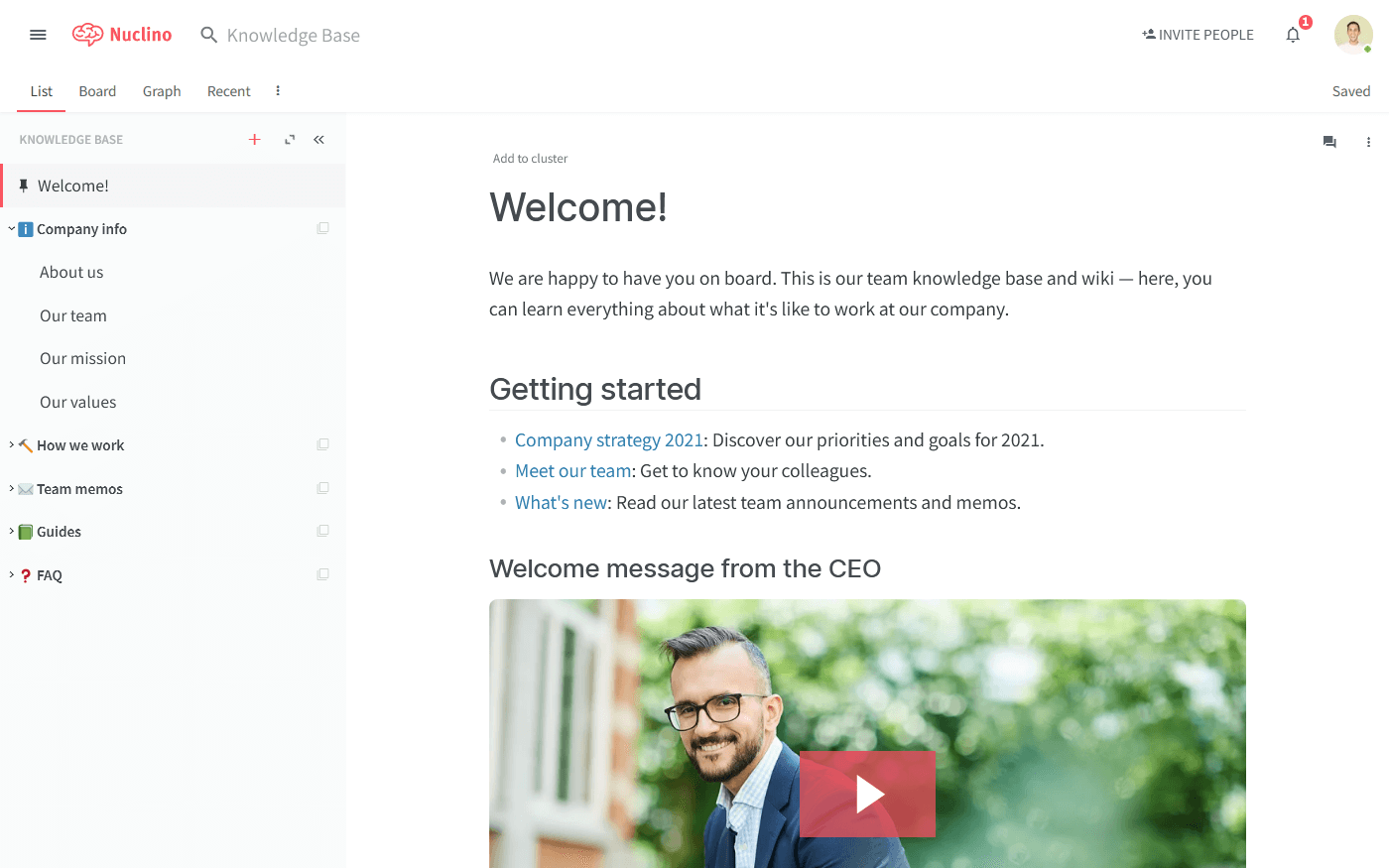
Pricing: Free, AI features starting from $10/user/month
Rating on Capterra: 4.7/5
If you want to build an AI knowledge base that is easy to use, lightweight, and collaborative, there is no better option than Nuclino. It's not feature-packed — by design. Instead, it focuses on getting the essentials just right: its interface is clean, the collaborative editing experience is frictionless, the search is fast and reliable.
Nuclino comes with a minimal learning curve, making it easy for the entire team to quickly get the hang of it. But its simplicity also doesn't preclude it from offering a wide range of AI knowledge management capabilities.
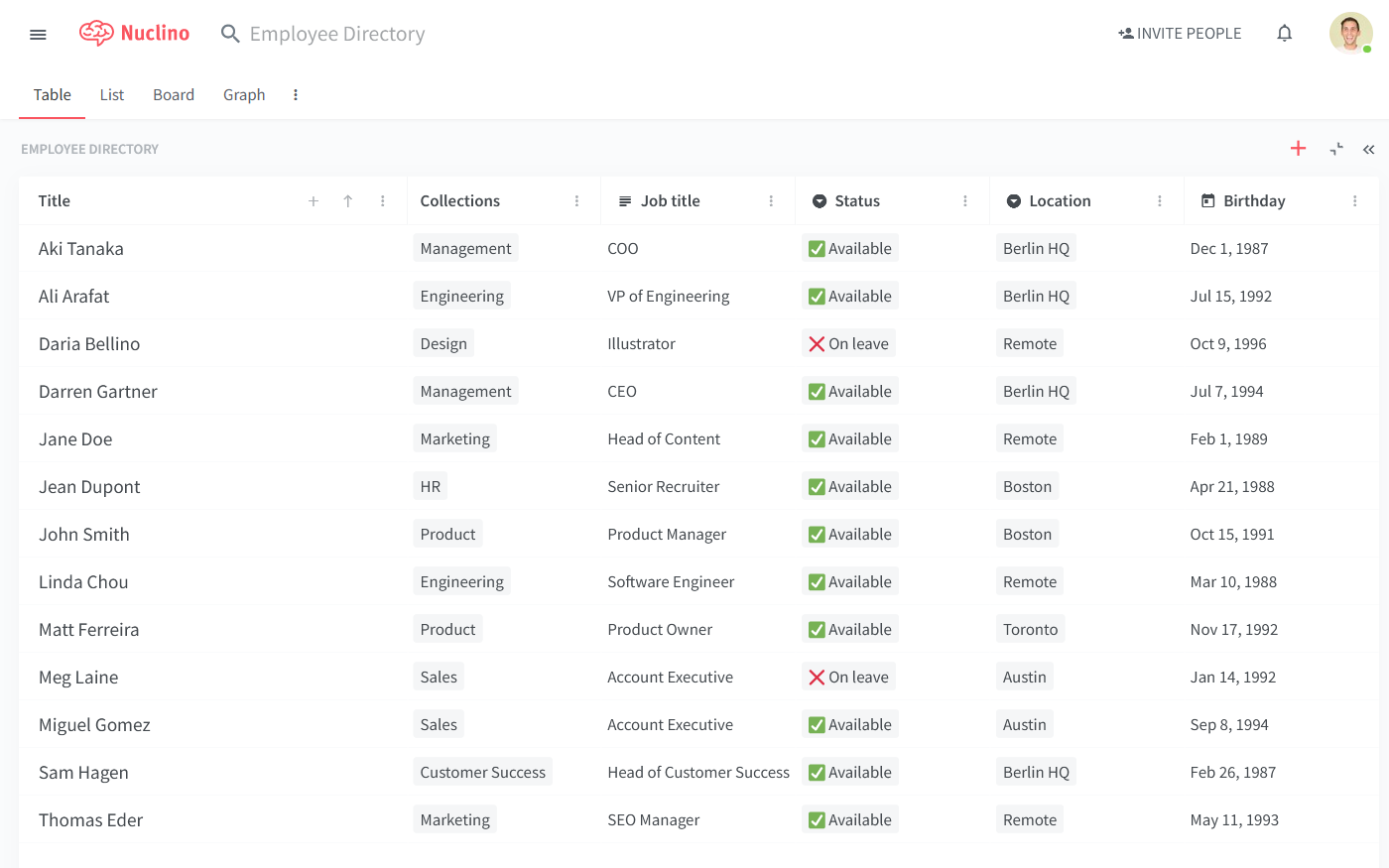
Nuclino offers powerful AI features that make finding information quick and easy. It comes with an AI-powered assistant Sidekick that can instantly answer any question based on your team's collective knowledge documented in the knowledge base.
Sidekick can also help you brainstorm ideas, create first drafts, summarize long documents, generate images, and more.
Another notable feature of Nuclino is its built-in visual collaboration. You can add an infinite collaborative canvas to any page of your knowledge base. You can use it to create diagrams and flowcharts, brainstorm ideas using sticky notes, build moodboards, and much more.
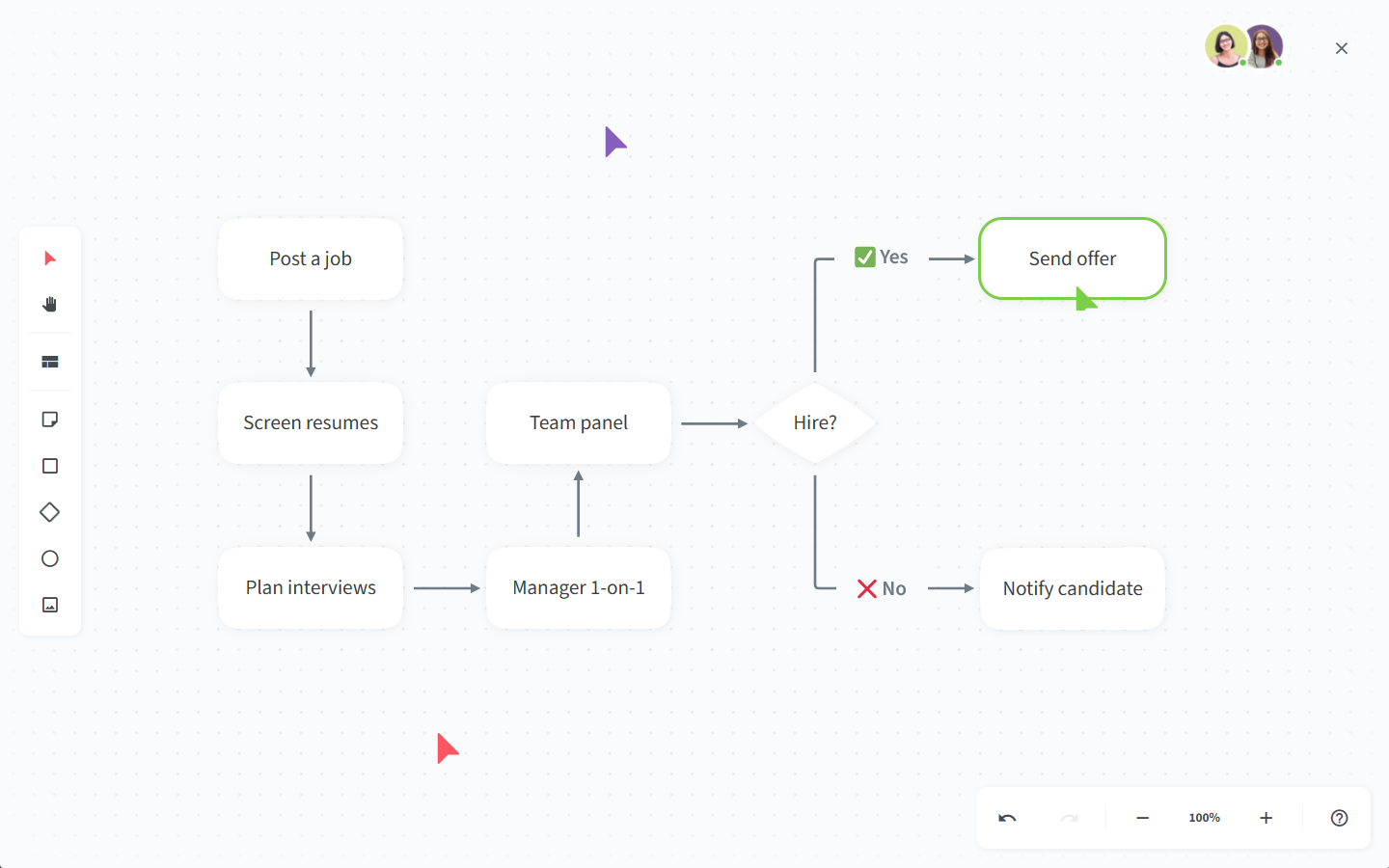
You can also turn any Nuclino workspace into a public website, accessible to anyone on the web and discoverable via search engines. It's perfect for help centers, user documentation, changelogs, and much more.
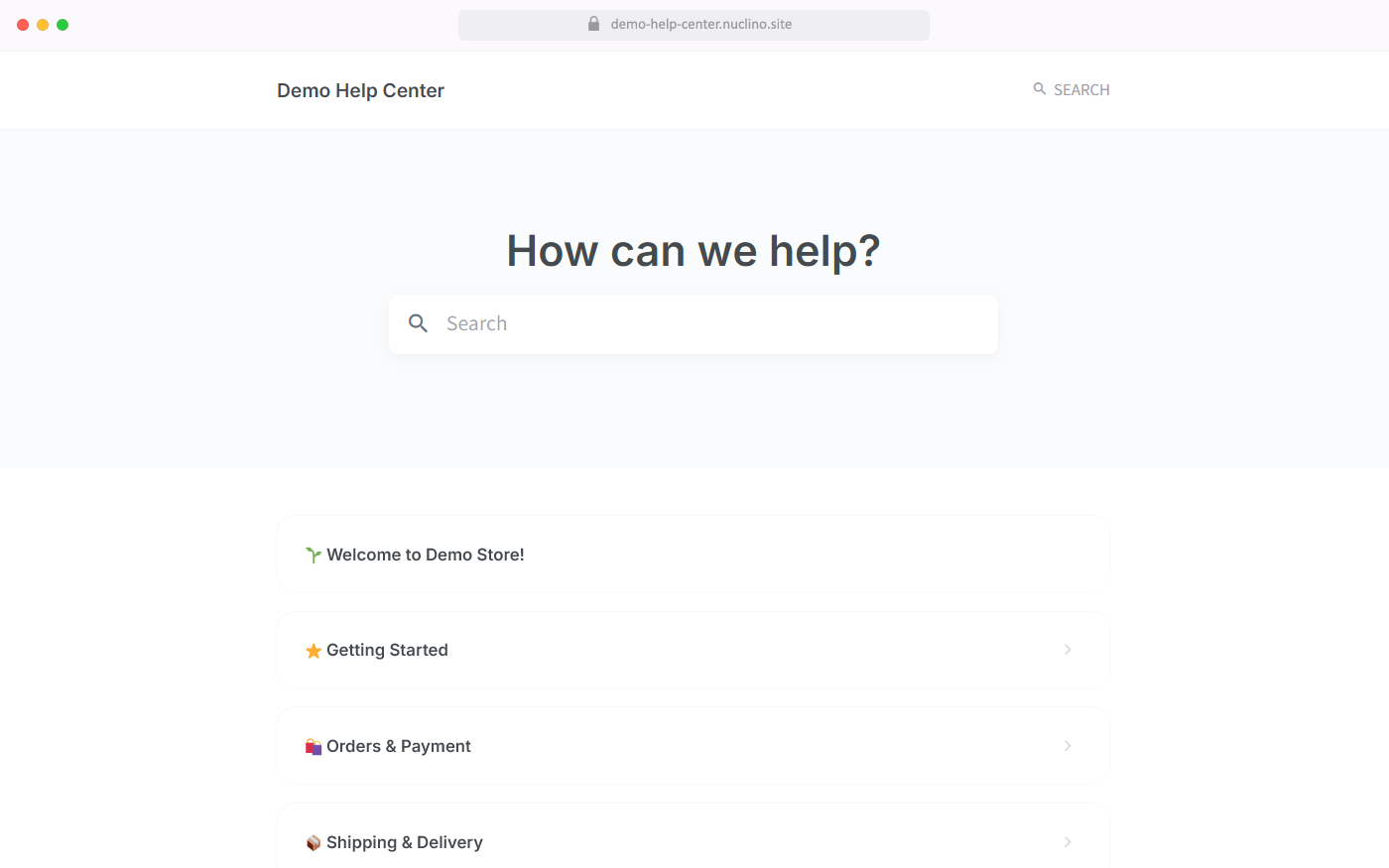
In addition to being a great tool for building your AI knowledge base, Nuclino can also be easily used for project collaboration, collaborative documentation, sprint planning, asynchronous communication, and much more. It works like a collective brain, allowing you to bring all your team's work together in one place and collaborate without the chaos of files and folders, context switching, or silos.
While Nuclino may not have some of the more advanced customer service-focused features of platforms like Zendesk, its strength lies in its simplicity and flexibility. It's particularly well-suited for internal knowledge management, team collaboration, and project documentation.
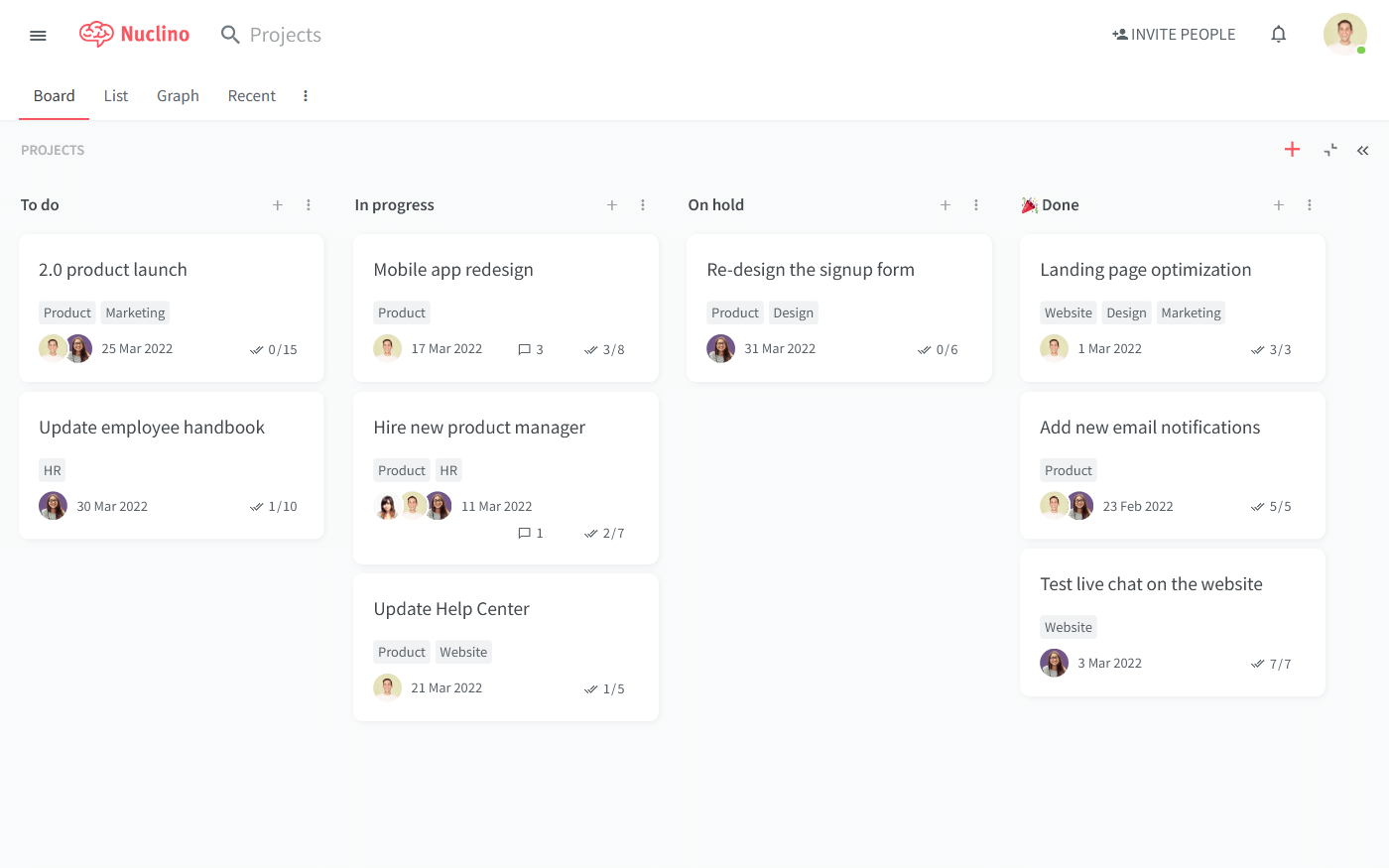
What users say about Nuclino:
"Great knowledge base for capturing information. We use Nuclino daily to make sure we're documenting everything — from sales playbooks to HR processes to specific data collection checklists. It's easy to use, update, comment, and share."
— Capterra review (read more reviews of Nuclino)
2. Document360
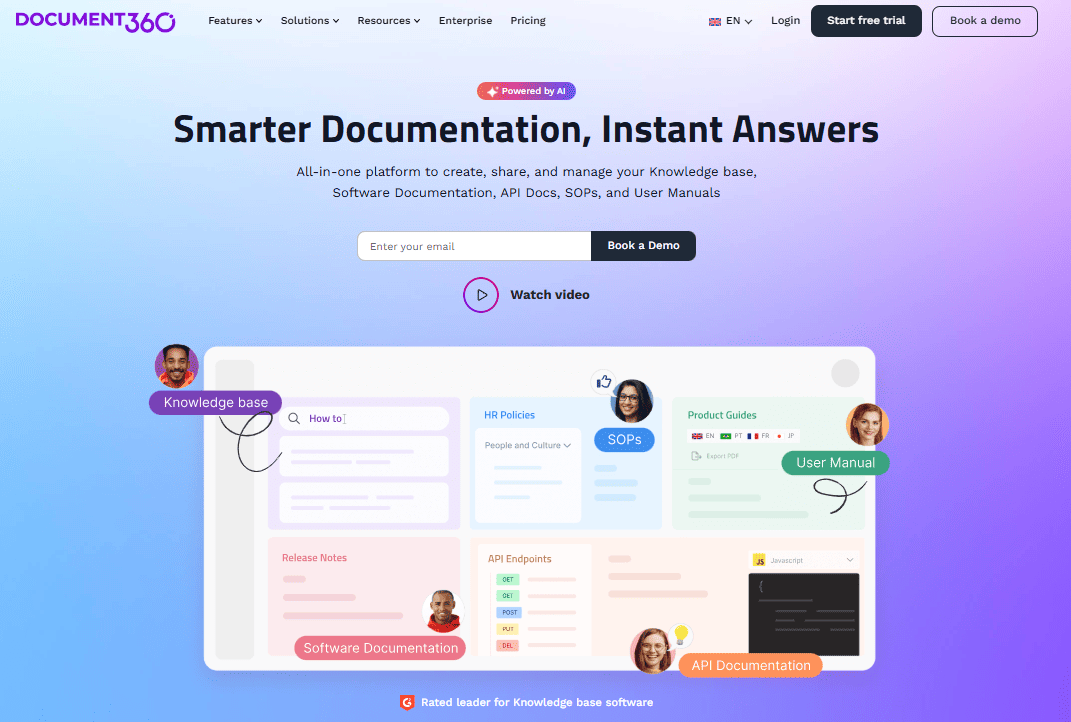
Pricing: Available on request
Rating on Capterra: 4.7/5
Document360 is an AI-powered knowledge base platform designed to help teams create, manage, and organize documentation efficiently. Its AI-driven search uses natural language processing (NLP) to deliver highly relevant results, ensuring faster information access for internal teams and end users.
The platform’s automated content recommendations suggest relevant articles based on user behavior. Document360 also supports Markdown and WYSIWYG editors, making it flexible for different documentation needs.
In addition to its AI features, Document360 offers version control, content approvals, and seamless integrations with tools like Microsoft Teams, Slack, and Intercom. The AI-powered analytics help teams track search performance, identify content gaps, and continuously improve the knowledge base based on real-time data.
What users say about Document360:
"Document360’s AI assistant, advanced editor, and Teams integration make knowledge management seamless. Its analytics and feedback automation save time, though features like callout icons and article subscriptions would be a great addition."
3. Zendesk
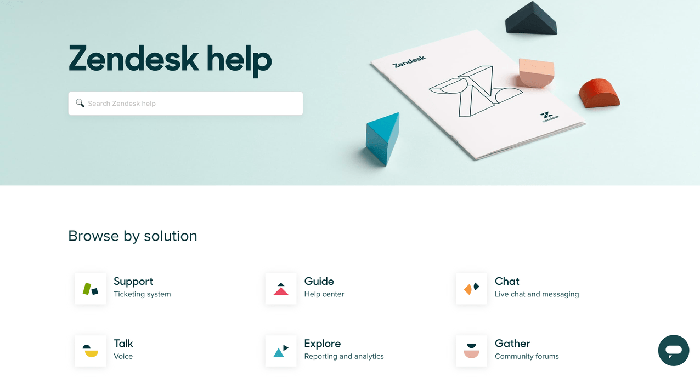
Pricing: Starting from $49/user/month
Rating on Capterra: 4.4/5
Zendesk's AI knowledge base is part of its broader customer service platform.
Its AI, called Content Cues, analyzes support tickets to identify common issues that aren't addressed in the knowledge base. For instance, if many customers are asking about a new product feature, Content Cues will suggest creating an article about it. This proactive approach helps keep the knowledge base current and relevant.
Zendesk's Answer Bot is another key feature. It can handle straightforward customer queries by pulling information from the knowledge base, freeing up human agents for more complex issues. In practice, this might mean the bot can handle password reset instructions or shipping queries, while agents focus on technical troubleshooting or personalized assistance.
What users say about Zendesk:
"The product is so easy to use. You can integrate any software to it to make your support processing streamlined and simple. We integrated Jira, Slack, Gmail, and TalkDesk. Zendesk also allows you to create a knowledge base within the system. Setting up automations can be difficult, but rewarding once you have the process down."
4. Help Scout
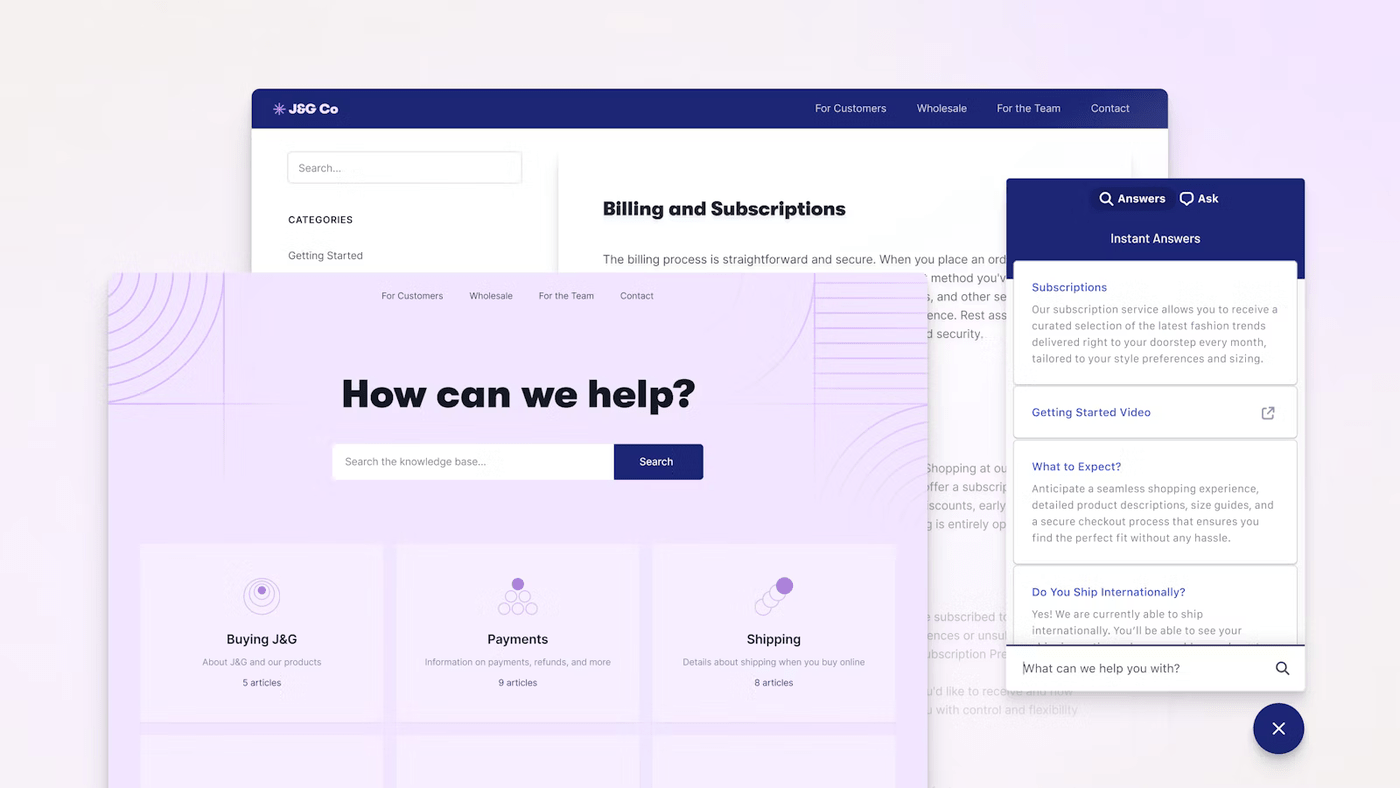
Pricing: Starting from $25/user/month
Rating on Capterra: 4.6/5
Help Scout's Docs feature brings AI capabilities to its knowledge base platform.
One of its most useful features is the ability to suggest relevant knowledge base articles to support agents in real-time. For example, as an agent types a response to a customer, the system might suggest a related article that the agent can quickly reference or share. This feature helps maintain consistency in responses and can significantly speed up resolution times.
Help Scout also provides detailed analytics on knowledge base usage. It can show which search terms are most common, which articles are most frequently accessed, and even which searches don't lead to satisfactory results. This information can be invaluable for continuously improving the knowledge base and ensuring it meets user needs.
What users say about Help Scout:
"Help Scout is really affordable and it's really simple and it does have limits but if you're just looking for a simple way to track your emails and to provide a chat option for your website and to create a knowledge base then it's a really great tool."
5. Bloomfire
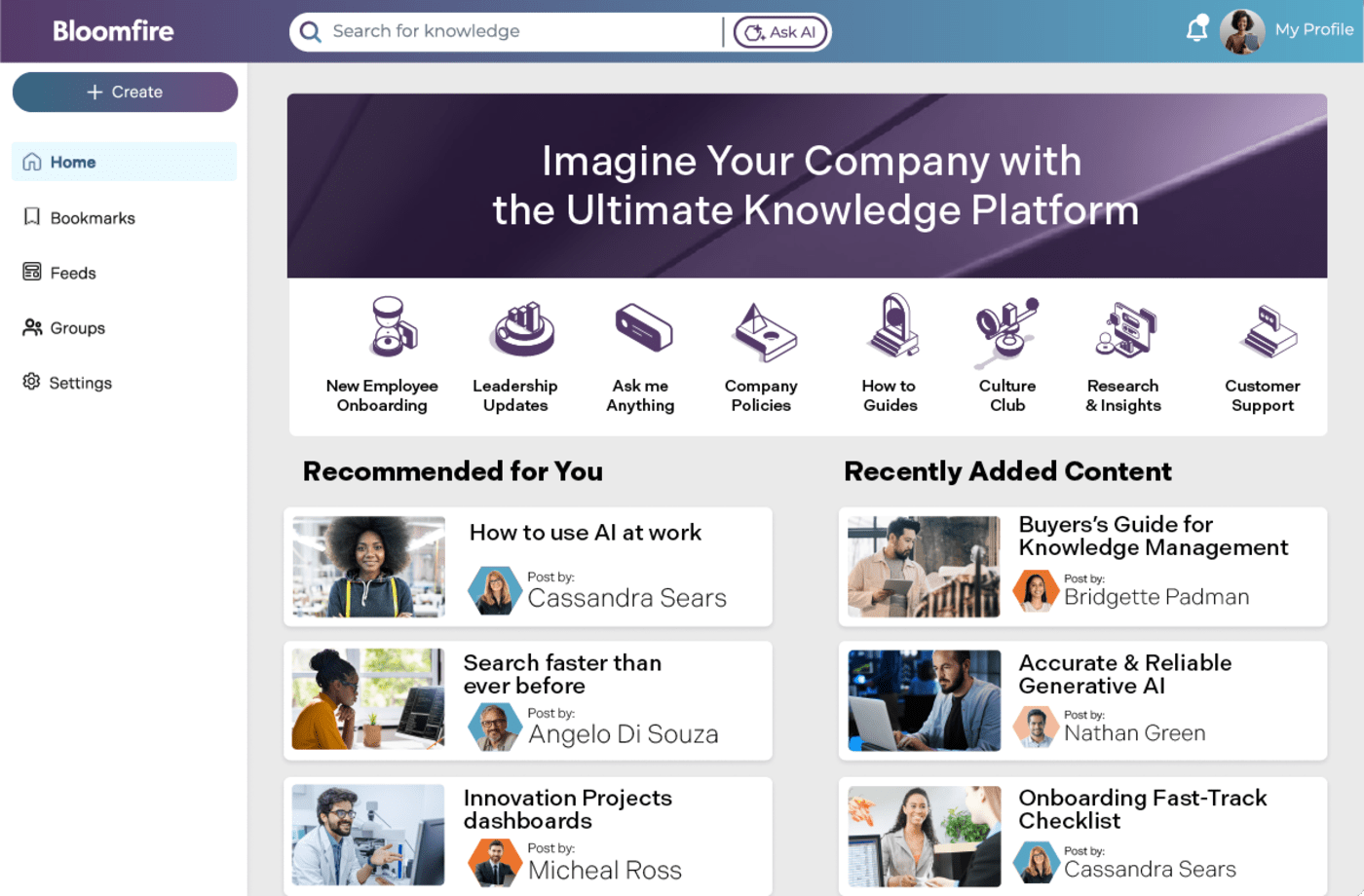
Pricing: Available on request
Rating on Capterra: 4.4/5
Bloomfire is a knowledge management platform that leverages AI to enhance information discovery and organization.
Its core AI functionality powers an intelligent search engine that uses natural language processing to understand user intent and deliver relevant results. The platform also employs AI for auto-tagging content, suggesting relevant tags as new information is added to the system, which helps maintain consistent categorization across the knowledge base.
Another key feature of Bloomfire's AI is its content recommendation system. As users interact with the platform, it learns from these interactions to suggest related content, helping to surface valuable information that might otherwise be overlooked.
Bloomfire also includes an AI-powered insights engine that analyzes user behavior and content performance, providing administrators with data-driven insights to guide content strategy.
What users say about Bloomfire:
"As one of Bloomfire's early customers we saw a lot of potential with this platform. I was in charge of conducting a report comparing some of the available products to satisfy our need for a customer-facing knowledge base. It had to be relevant, easy to use, and fast. We had a lot of undocumented information that our customers needed with no way to provide it. Bloomfire came out on top."
How do AI knowledge bases work?
Most AI knowledge bases operate on the principle of continuous improvement, using advanced algorithms to enhance both the management and retrieval of information. Here’s a closer look at the key technologies involved:
Natural Language Processing (NLP): NLP allows AI knowledge bases to understand and interpret human language. This means the system can comprehend complex queries, recognize the intent behind a user's search, and provide relevant information without requiring exact keyword matches.
Machine Learning (ML): Machine learning enables the system to learn from interactions over time. By analyzing patterns in user behavior, feedback, and search results, ML algorithms refine the system’s responses and recommendations, making the knowledge base more accurate and efficient.
When users interact with an AI knowledge base, the system learns from these interactions, refining its understanding of language nuances and adapting its responses accordingly. This ability to evolve over time is what sets AI knowledge bases apart from their traditional counterparts.
Key features of AI knowledge bases
There are several features that usually set these systems apart from traditional knowledge management solutions:
AI-powered search: The heart of any AI knowledge base is its search capability. Unlike simple keyword matching, AI-powered search understands context and intent. It can interpret complex queries, handle natural language input, and even understand misspellings or colloquialisms.
Natural language understanding: This feature allows the system to interpret and respond to queries in natural language. Users can ask questions as they would to a human agent, and the system can understand and provide relevant answers.
Content generation: Some advanced AI knowledge bases can assist in creating new content. They might generate summaries of existing articles, create new articles based on common queries, or even translate content into different languages.
Personalization: Some AI knowledge bases can tailor their responses based on user history, preferences, and context. For example, a returning user might receive different information than a first-time visitor, or a user accessing the system from a mobile device might get responses optimized for that format.
The benefits of an AI-powered knowledge base
Implementing an AI-powered knowledge base offers a range of benefits that can significantly impact both customer experience and business operations.
Here are some of the key advantages:
Better self-service customer support: AI-powered external knowledge bases help customers to find solutions independently, without the need for human intervention. This not only improves customer satisfaction but also reduces the workload on support teams.
Easier knowledge management: AI can assist in managing and creating content by identifying gaps, flagging outdated resources, and suggesting new topics based on user interactions. For instance, if there’s a spike in queries about a specific issue, the AI can recommend creating new content to address this need, ensuring that the knowledge base remains relevant and up-to-date.
Improved onboarding: For new employees, an AI knowledge base can be an invaluable resource. By providing easy access to comprehensive, up-to-date information, these systems help new hires get up to speed quickly.
Cost reduction: By enabling self-service customer support and improving the efficiency of support teams, AI-driven knowledge bases can significantly reduce operational costs. Fewer support tickets mean a smaller, more efficient support team, allowing businesses to allocate resources more effectively.
How to build an AI knowledge base
Building an AI knowledge base involves several key steps to ensure that the system meets your business’s specific needs.
Here’s a step-by-step guide:
Define your goals
Start by identifying the primary objectives for your AI knowledge base. Whether you’re focusing on improving customer self-service, enhancing internal knowledge sharing, or both, clear goals will guide your decisions throughout the implementation process.
Choose the right AI knowledge base software
Research and select an AI-powered knowledge base platform that aligns with your goals. Consider factors like AI capabilities, ease of use, integration options, and scalability. Many platforms offer free trials, allowing you to test their features before making a commitment. There are also many free knowledge base tools worth evaluating.
Gather and prepare the content
Collect all relevant data sources, including existing documentation, FAQs, and customer interactions. Organize and clean this data to ensure it’s ready for AI analysis. High-quality data is crucial for the effectiveness of your AI models.
Design the structure
Develop a structure for your knowledge base that makes it easy to find and retrieve information. Consider using a combination of structured and unstructured formats, and implement a tagging or categorization system to facilitate efficient searches.
Create and update content
Populate your knowledge base with high-quality, relevant content. Regularly update and expand this content to ensure it remains accurate and useful. AI can assist in identifying content gaps and recommending new topics based on user interactions.
Monitor and improve
Continuously monitor the performance of your AI knowledge base using analytics and user feedback. Regular updates and refinements will ensure that the system evolves to meet the changing needs of your business.
AI knowledge base FAQ
How does an AI knowledge base improve customer service?
An AI knowledge base enhances customer service by providing quick, accurate responses to user queries, reducing the need for human intervention, and ensuring that information is consistent and up-to-date across all channels.
What are the key components of an AI knowledge base?
Key components include natural language processing (NLP), machine learning (ML), structured and unstructured content management, automated content generation, and advanced search functionalities.
How do I choose the right AI knowledge base software?
Consider factors like AI capabilities, ease of use, integration options, scalability, and cost. Testing different platforms through free trials can also help you determine which software best meets your business’s needs. If the purchase involves a formal agreement, reviewing the terms carefully is key – contract analytics solutions can help speed up that process and flag any risks in the contract before you commit.
Ready to get started?
